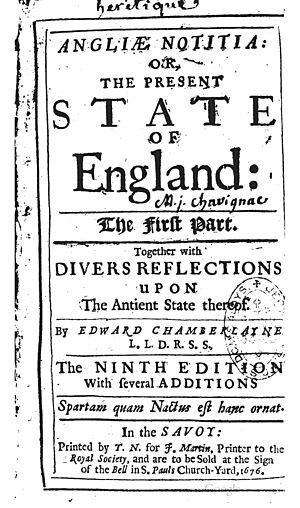Edward Chamberlayne facts for kids
Edward Chamberlayne (born December 13, 1616 – died May 1703) was an English writer. He is most famous for his book, The Present State of England. This book was like a guide to England at the time.
Contents
Edward Chamberlayne's Life
Edward Chamberlayne was born in Oddington, England, on December 13, 1616. His grandfather was Sir Thomas Chamberlayne, who was once an English ambassador.
Early Education and Studies
Edward first went to school in Gloucester. Later, in 1634, he started studying at St Edmund Hall, Oxford, a college at Oxford. He earned his first degree, a Bachelor of Arts (B.A.), in 1638. Then, in 1641, he earned a Master of Arts (M.A.) degree. For part of 1641, he taught rhetoric at Oxford.
Travels and Royal Connections
When the First English Civil War began, Edward traveled a lot. He visited many countries in Europe, including France, Spain, Italy, and Sweden. After the war, during the English Restoration (when the king returned to power), he came back to England.
In 1669, he became a secretary for Charles Howard, 1st Earl of Carlisle. He even traveled to Stockholm to help give a special award, the Order of the Garter, to Charles XI of Sweden.
Edward also earned more advanced degrees. He became a Doctor of Laws (LL.D.) from Cambridge in 1671. He also became a Doctor of Civil Law (D.C.L.) from Oxford in 1672. Around 1679, he became a tutor for Henry Fitzroy, 1st Duke of Grafton, who was King Charles II's son. Later, he taught English to Prince George of Denmark. Edward was also one of the first members of the Royal Society, a famous group for scientists.
Later Life and Death
In his later years, Edward lived in Chelsea. He passed away there in May 1703. He was buried on May 27 in a vault at Chelsea churchyard. His friend, Walter Harris, wrote a long message in Latin for his tombstone.
Edward Chamberlayne's Books
Edward Chamberlayne's most famous book is Angliæ Notitia, or The Present State of England. This book was a guide to England's society and government. It also listed public officials and included facts about the country. It was based on a similar book about France.
The Present State of England
The first version of The Present State of England came out in 1669 without his name on it. Later that year, two more versions were published with his name. The book became very popular. New editions were released often, adding more information. For example, the seventh edition in 1673 included a picture of King Charles II.
Edward published the twentieth edition of his book in 1702. After he died, his son, John Chamberlayne, continued to update and publish it. The twenty-first edition, published in 1708, had a new title: Magnæ Britanniæ Notitia, or the Present State of Great Britain. This showed that it now covered all of Great Britain. The book was so popular that it continued to be published until 1755, with a total of thirty-six editions.
Influence and Other Works
Edward Chamberlayne's book was important. It even inspired other writers, like William Petty, to write similar books about economics and statistics.
Another writer, Guy Miege, copied parts of Chamberlayne's book. Miege published his own book, The New State of England, in 1691. Even though the Chamberlaynes pointed out this plagiarism (copying someone else's work without permission), Miege kept publishing his book until 1748.
Edward Chamberlayne also wrote other books, including:
- The Present War Parallel'd, or a Brief Relation of the Five Years' Civil Wars of Henry III, King of England (1647). This book was about an old English civil war.
- England's Wants (1667).
- The Converted Presbyterian, or the Church of England Justified in Some Practices (1668).
- An Academy or College wherein Young Ladies and Gentlemen may at a Very Moderate Expence be Educated in the True Protestant Religion and in All Virtuous Qualities (1671). This book was about educating young people.
- A Dialogue between an Englishman and a Dutchman concerning the Late Dutch War (1672).
In 1653, Edward also published a book of translations. These were stories from Italian, Spanish, and Portuguese languages.
Edward Chamberlayne's Family
In 1658, Edward Chamberlayne married Susannah Clifford. They had nine children together. His son, John Chamberlayne (1666–1723), later continued his father's work on The Present State of England. Edward's wife, Susannah, passed away on December 17, 1703, and was buried next to him.


